Numerical Study on the Cavitation Characteristics of Micro Automotive Electronic Pumps under Thermodynamic Effect
Abstract
:1. Introduction
2. Three-Dimensional Model and Grid Division
2.1. Model Pump Parameters
2.2. Division of Computational Grid
3. Numerical Method
3.1. Turbulence Model
3.2. Modification of Cavitation Model Considering Thermodynamic Effects
3.3. Boundary Condition Setting
3.4. Monitoring Point Setting
4. Analysis of Internal Flow of Automotive Electronic Water Pump under Non-Cavitation Condition
4.1. Verification of External Characteristics by Numerical Calculation
4.2. Pressure Field Distribution in the Pump at Different Temperatures
5. Automotive Electronic Water Pump Cavitation Performance Analysis
5.1. Computational Analysis of Cavitation Performance Considering Thermodynamic Effects
5.2. Cavitation Steady Analysis Considering Thermodynamic Effects
5.2.1. Bubble Shape during Cavitation Formation
5.2.2. Analysis of the Pressure Field during Cavitation Formation
5.2.3. Cavitation Flow Field Analysis
5.3. Cavitation Transient Analysis Considering Thermodynamic Effects
5.3.1. Transient Bubble in the Impeller
5.3.2. Comparative Analysis of Pressure Pulsation in the Frequency Domain
6. Conclusions
- The static pressure distribution of the automotive electronic water pump is similar at different temperatures. When operating under different flow conditions, there is a local low-pressure area on the suction surface of the blade that is more prone to cavitation, and the range of the low-pressure area gradually increases as the flow rate increases. Under the large flow condition (1.2Qd), the area of the low-pressure area at the inlet gradually decreases as the temperature increases.
- An automotive electronic water pump is sensitive to cavitation; once cavitation occurs will lead to a sharp deterioration in hydraulic performance. The required net positive suction head will decrease with the increase in temperature; the higher the temperature of the automotive electronic water pump’s anti-cavitation performance, the less likely cavitation is.
- When the inlet pressure of the automotive electronic water pump is large, no cavitation is generated inside the impeller. When the inlet pressure decreases to a certain value, the bubble starts to be generated on the suction surface of the impeller. It gradually increases with the decrease of the inlet pressure. The impeller’s five blades in the low-pressure area and the bubble cluster show the same pattern, and the expansion of the bubble cluster and the expansion in the low-pressure area of the impeller show the same trend. The pressure is closely related to the generation and development of cavitation.
- Along with the impeller runner from the blade inlet to the blade outlet, each monitoring point’s pressure pulsation amplitude gradually increased, and the amplitude frequency of the axial frequency and its multiplier frequency, as well as the pressure pulsation amplitude at the axial frequency, reached the maximum. In the high-frequency region, the pressure pulsation amplitude at the blade suction surface, the middle of the flow channel, and the blade pressure surface gradually increases along the inlet to the outlet. From no cavitation to cavitation, the maximum value of the pressure pulsation at the working surface gradually increases and reaches a maximum at the outlet.
- This study is focused on the cavitation flow field characteristics at different operating points of a high-speed automotive electronic water pump at a rated speed (5400 r/min). In order to better prevent and reduce the cavitation phenomenon of the automotive electronic pump, our future research will focus on the cavitation monitoring technology, and we will establish a cavitation intelligent monitoring system to monitor the operating status of the automotive electronic water pump in real time.
Author Contributions
Funding
Institutional Review Board Statement
Informed Consent Statement
Data Availability Statement
Acknowledgments
Conflicts of Interest
References
- Utturkar, Y.; Wu, J.; Wang, G.; Shyy, W. Recent progress in modeling of cryogenic cavitation for liquid rocket propulsion. Prog. Aerosp. Sci. 2005, 41, 558–608. [Google Scholar] [CrossRef]
- Li, Y.; Feng, G.; Li, X.; Si, Q.; Zhu, Z. An experimental study on the cavitation vibration characteristics of a centrifugal pump at normal flow rate. J. Mech. Sci. Technol. 2018, 32, 4711–4720. [Google Scholar] [CrossRef]
- Tao, R.; Xiao, R.; Wang, F.; Liu, W. Cavitation behavior study in the pump mode of a reversible pump-turbine. Renew. Energy 2018, 125, 655–667. [Google Scholar] [CrossRef]
- Fang, Y.; Zhang, J.; Xu, B.; Huang, C.S.; Guo, Z. A study on increasing the speed limit of axial piston pumps by optimizing the suction duct. Chin. J. Mech. Eng. 2021, 34, 1–10. [Google Scholar] [CrossRef]
- Mao, Z.B.; Asai, Y.; Winranata, A.; Kong, D.Q.; Man, J. Eccentric actuator driven by stacked electrohydrodynamic pumps. J. Zhejiang Univ. Sci. A 2022, 23, 6. [Google Scholar] [CrossRef]
- Fruman, D.H.; Reboud, J.-L.; Stutz, B. Estimation of thermal effects in cavitation of thermo sensible liquids. Int. J. Heat Mass Transf. 1999, 42, 3195–3204. [Google Scholar] [CrossRef]
- Franc, J.-P.; Rebattet, C.; Coulon, A. An Experimental Investigation of Thermal Effects in a Cavitating Inducer. J. Fluids Eng. 2004, 126, 716. [Google Scholar] [CrossRef]
- Cervone, A.; Testa, R.; Bramanti, C.; Rapposelli, E.; D’Agostino, L. Thermal Effects on Cavitation Instabilities in Helical Inducers. J. Propuls. Power 2005, 21, 893–899. [Google Scholar] [CrossRef]
- Yoshida, Y.; Kikuta, K.; Hasegawa, S.; Shimagaki, M.; Tokumasu, T. Thermodynamic Effect on a Cavitating Inducer in Liquid Nitrogen. J. Fluids Eng. 2007, 129, 273. [Google Scholar] [CrossRef]
- Kikuta, K.; Yoshida, Y.; Watanabe, M.; Hashimoto, T.; Nagaura, K.; Ohira, K. Thermodynamic Effect on Cavitation Performances and Cavitation Instabilities in an Inducer. J. Fluids Eng. 2008, 130, 111302. [Google Scholar] [CrossRef]
- Gustavsson, J.P.R.; Denning, K.C.; Segal, C. Hydrofoil Cavitation Under Strong Thermodynamic Effect. J. Fluids Eng. 2008, 130, 091303. [Google Scholar] [CrossRef]
- Gustavsson, J.P.R.; Denning, K.C.; Segal, C.; Dorney, D.J. Incipient Cavitation Studied Under Strong Thermodynamic Effect. AIAA J. 2009, 47, 710–716. [Google Scholar] [CrossRef]
- Si, Q.; Asad, A.; Wang, B.; Peng, W.; Gerard, B.; Yuan, J.; Ameer, A. Numerical study on gas-liquid two phase flow characteristic of multistage electrical submersible pump by using a novel multiple-size group (MUSIG) model. Phys. Fluids 2022, 34, 063311. [Google Scholar] [CrossRef]
- Ali, A.; Yuan, J.; Deng, F.; Wang, B.; Liu, L.; Si, Q.; Buttar, N.A. Research Progress and Prospects of Multi-Stage Centrifugal Pump Capability for Handling Gas-Liquid Multiphase Flow: Comparison and Empirical Model Validation. Energies 2021, 14, 896. [Google Scholar] [CrossRef]
- Si, Q.; Ali, A.; Yuan, J.; Fall, I.; Muhammad Yasin, F. Flow-Induced Noises in a Centrifugal Pump: A Review. Sci. Adv. Mater. 2019, 11, 909. [Google Scholar] [CrossRef]
- Deshpande, M.; Feng, J.; Merkle, C.L. Numerical Modeling of the Thermodynamic Effects of Cavitation. J. Fluids Eng. 1997, 119, 420. [Google Scholar] [CrossRef]
- Franc, J.-P.; Pellone, C. Analysis of Thermal Effects in a Cavitating Inducer Using Rayleigh Equation. J. Fluids Eng. 2007, 129, 974. [Google Scholar] [CrossRef]
- Hosangadi, A.; Ahuja, V. Numerical Study of Cavitation in Cryogenic Fluids. J. Fluids Eng. 2005, 127, 267. [Google Scholar] [CrossRef]
- Watanabe, S.; Hidaka, T.; Horiguchi, H.; Furukawa, A.; Tsujimoto, Y. Steady Analysis of the Thermodynamic Effect of Partial Cavitation Using the Singularity Method. J. Fluids Eng. 2007, 129, 121. [Google Scholar] [CrossRef]
- Goel, T.; Thakur, S.; Haftka, R.T.; Shyy, W.; Zhao, J. Surrogate model-based strategy for cryogenic cavitation model validation and sensitivity evaluation. Int. J. Numer. Methods Fluids 2008, 58, 969–1007. [Google Scholar] [CrossRef] [Green Version]
- Tani, N.; Tsuda, S.; Yamanishi, N.; Yoshida, Y. Development and validation of new cryogenic cavitation model for rocket turbopump inducer. In Proceedings of the CAV2009, Ann Arbor, MI, USA, 17–22 August 2009; p. 63. [Google Scholar]
- Tseng, C.-C.; Shyy, W. Modeling for isothermal and cryogenic cavitation. Int. J. Heat Mass Transf. 2010, 53, 513–525. [Google Scholar] [CrossRef]
- De Giorgi, M.G.; Bello, D.; Ficarella, A. Analysis of Thermal Effects in a Cavitating Orifice Using Rayleigh Equation and Experiments. J. Eng. Gas Turbines Power 2010, 132, 092901. [Google Scholar] [CrossRef]
- Ali, A.; Si, Q.; Wang, B.; Yuan, J.; Wang, P.; Rasool, G.; Shokrian, A.; Ali, A.; Zaman, M.A. Comparison of empirical models using experimental results of electrical submersible pump under two-phase flow: Numerical and empirical model validation. Phys. Scr. 2022, 97, 065209. [Google Scholar] [CrossRef]
- Ali, A.; Si, Q.; Yuan, J.; Shen, C.; Cao, R.; Saad AlGarni, T.; Awais, M.; Aslam, B. Investigation of energy performance, internal flow and noise characteristics of miniature drainage pump under water-air multiphase flow: Design and part load conditions. Int. J. Environ. Sci. Technol. 2021, 1–18. [Google Scholar] [CrossRef]
- Deng, Y.; Feng, J.; Wan, F.; Shen, X.; Xu, B. Evaluation of the Turbulence Model Influence on the Numerical Simulation of Cavitating Flow with Emphasis on Temperature Effect. Processes 2020, 8, 997. [Google Scholar] [CrossRef]
- Rayleigh, L. VIII. On the pressure developed in a liquid during the collapse of a spherical cavity. Lond. Edinb. Dublin Philos. Mag. J. Sci. 1917, 34, 94–98. [Google Scholar] [CrossRef]
- Singhal, A.K.; Athavale, M.M.; Li, H.; Jiang, Y. Mathematical Basis and Validation of the Full Cavitation Model. J. Fluids Eng. 2002, 124, 617. [Google Scholar] [CrossRef]
- Brennen, C.E. Cavitation and Bubble Dynamics; Oxford University Press: Oxford, UK, 1995. [Google Scholar]
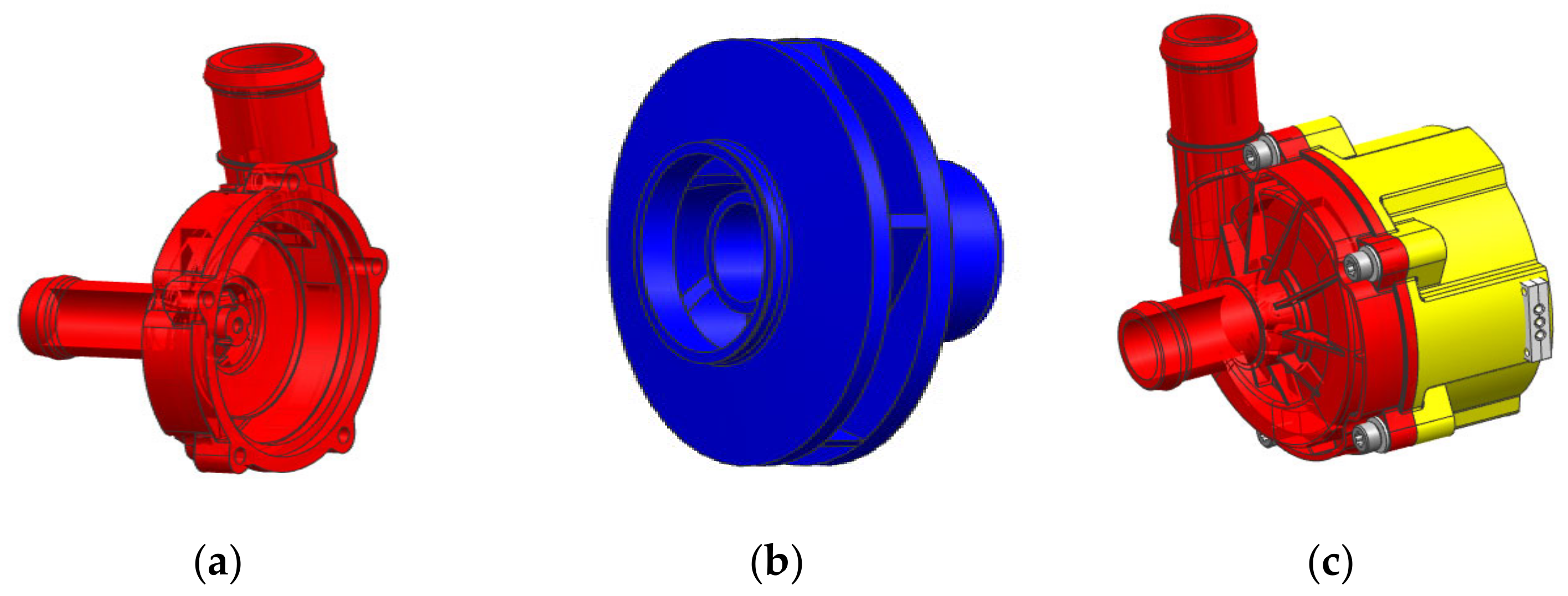

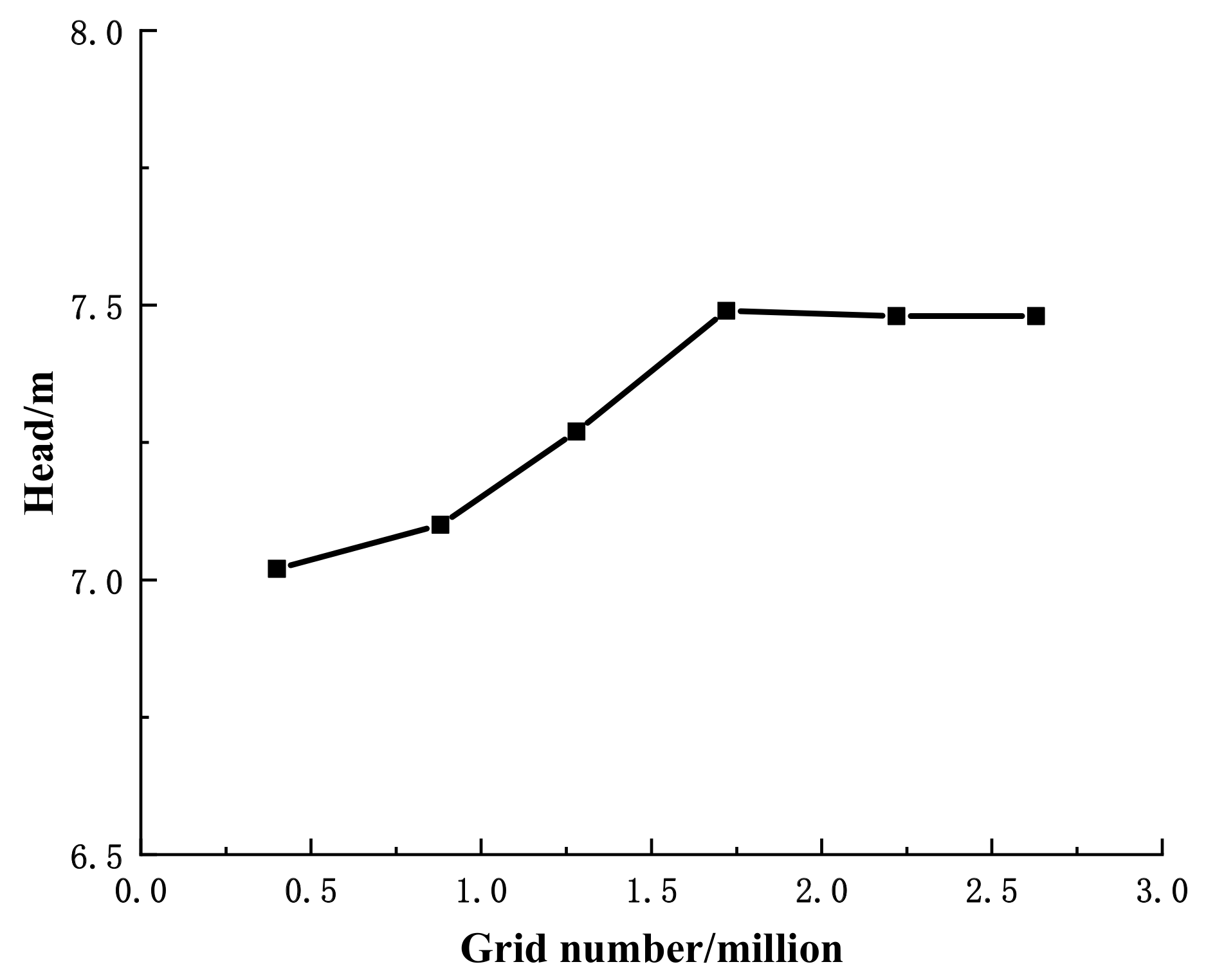
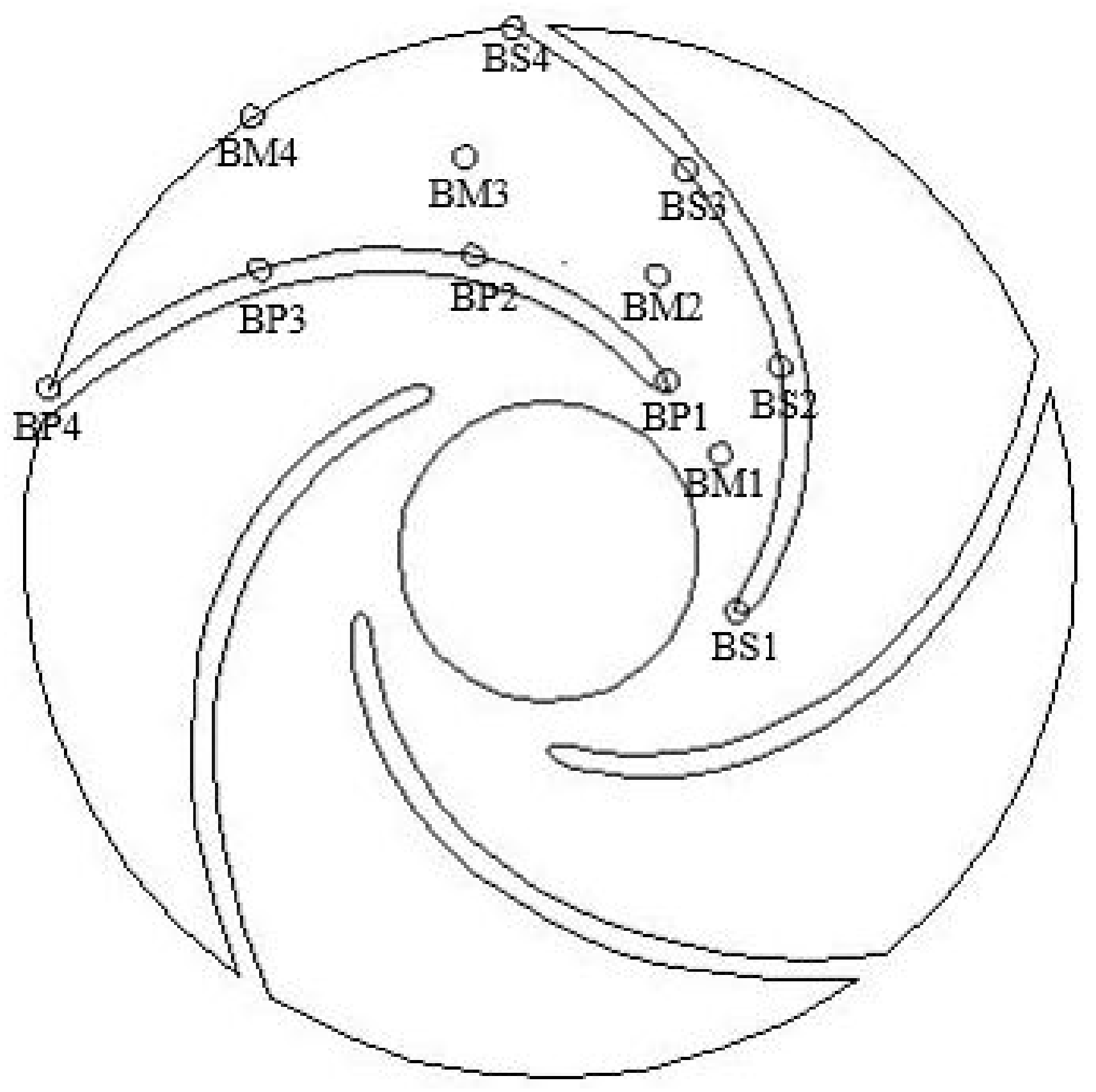
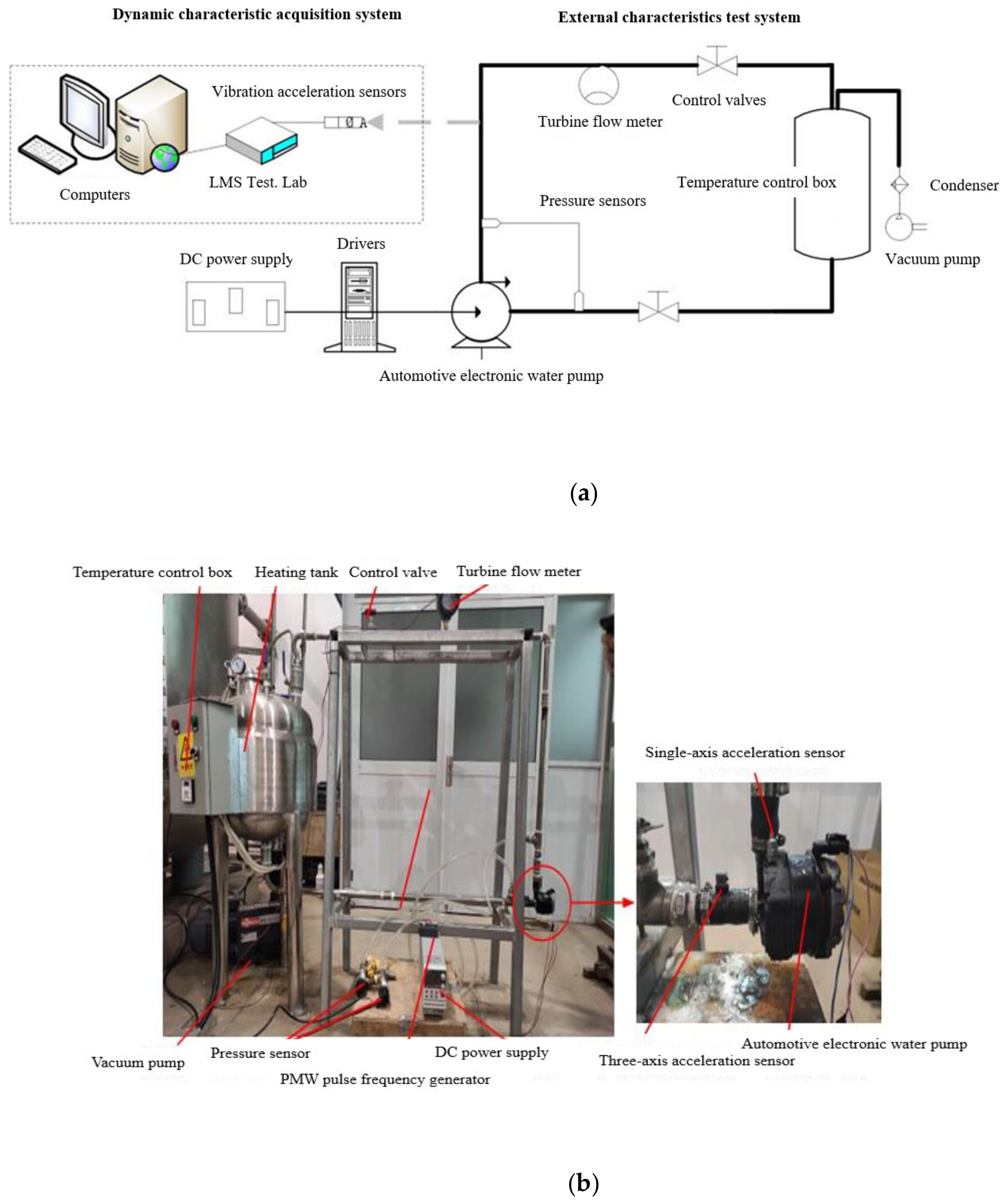
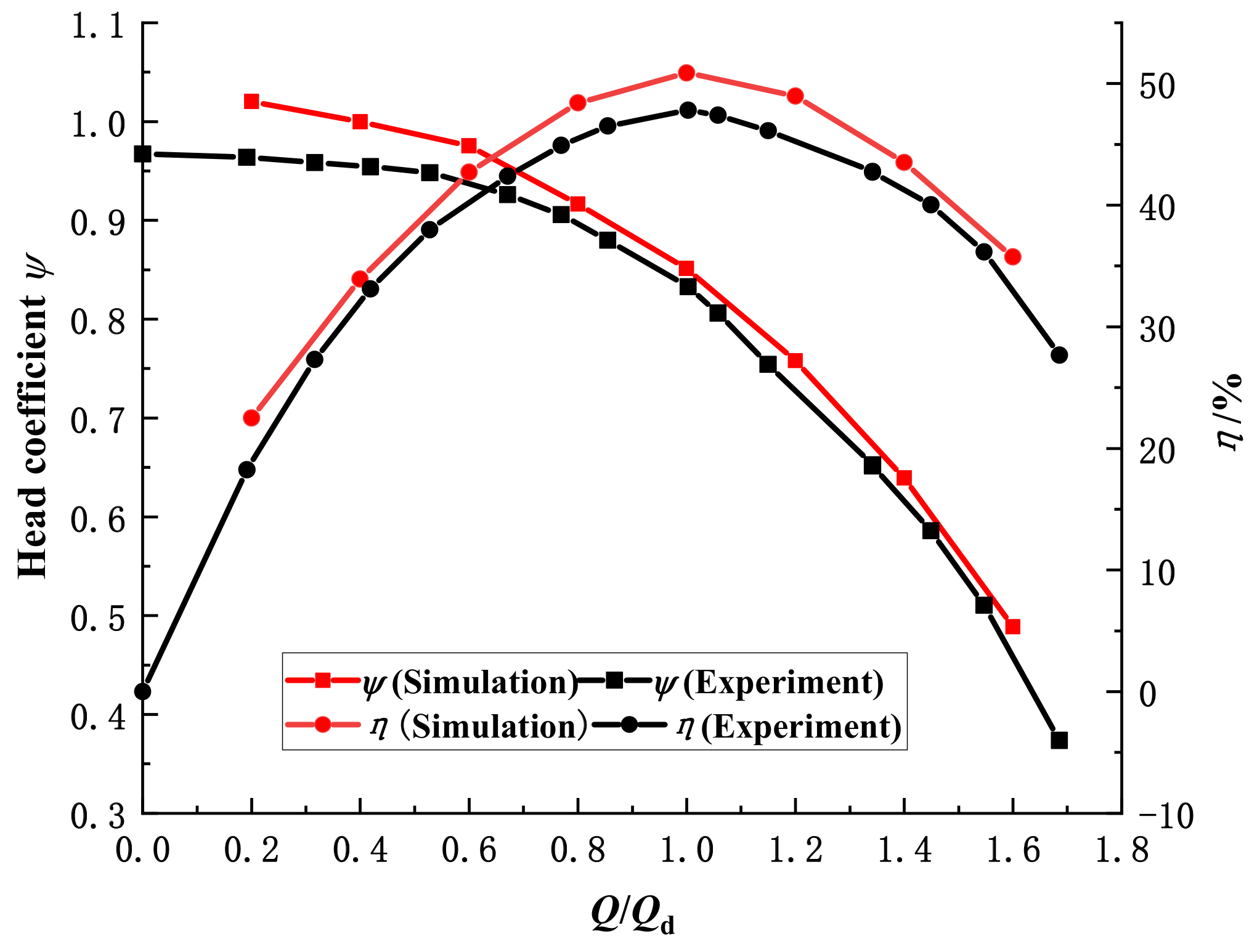

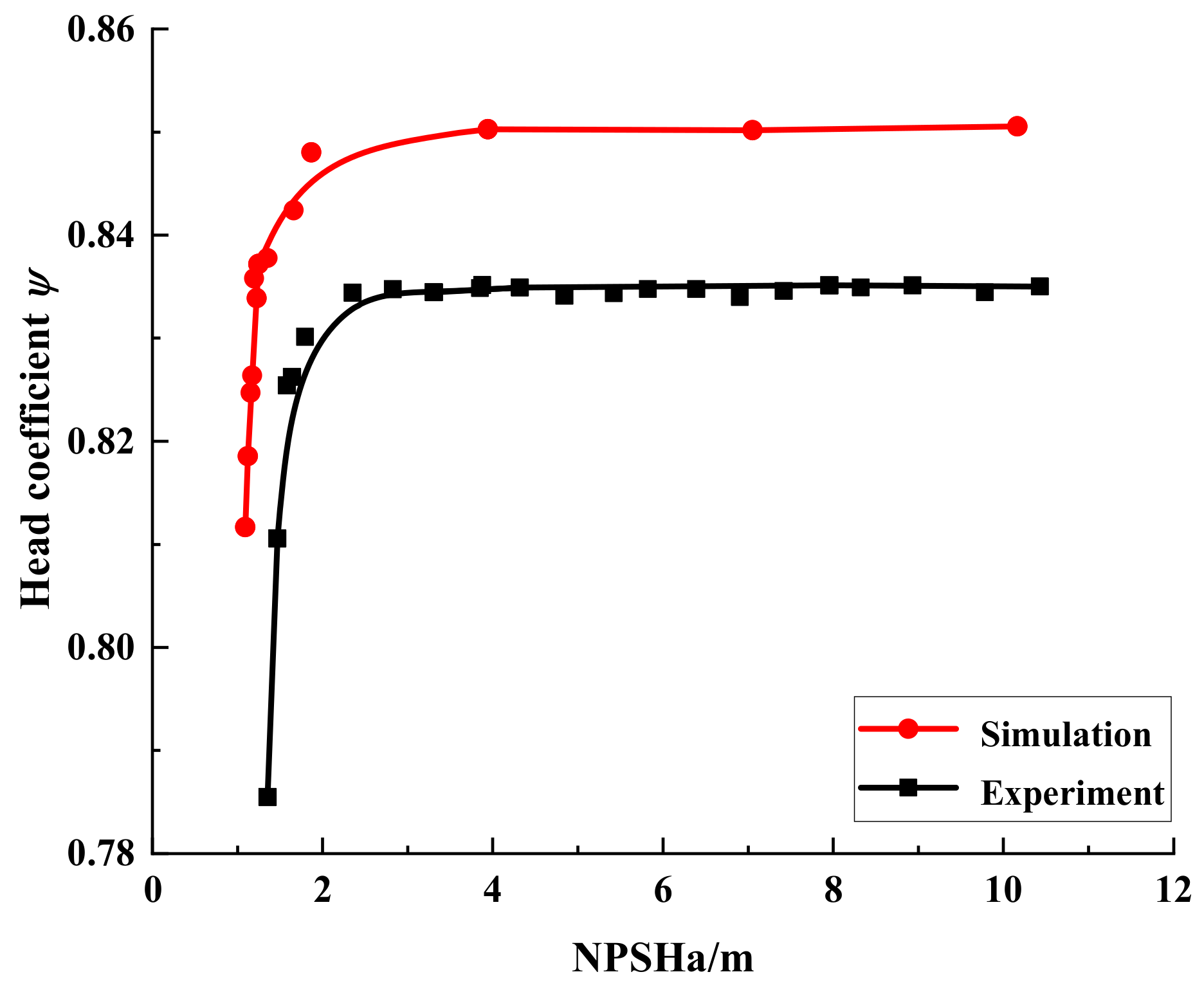
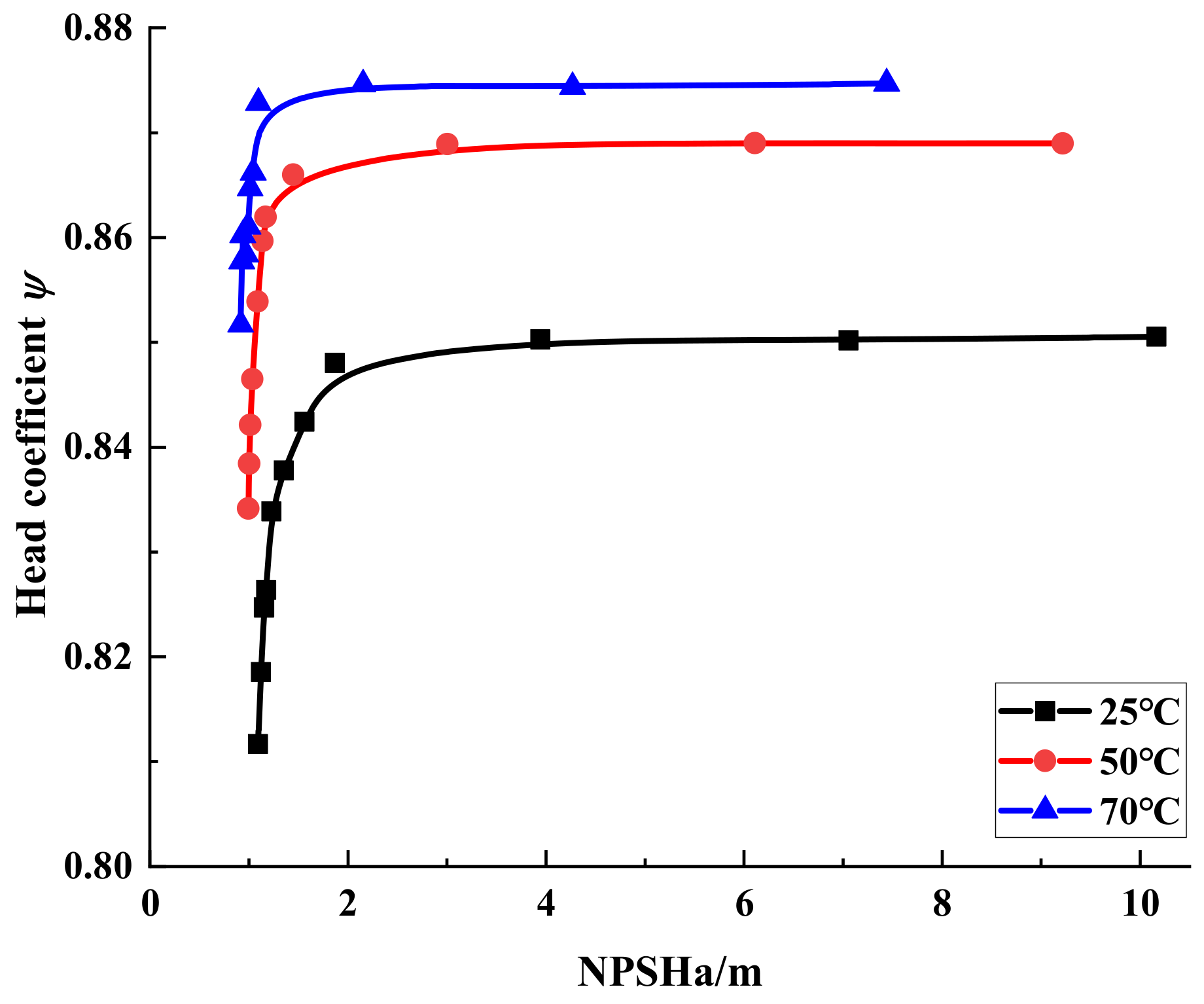


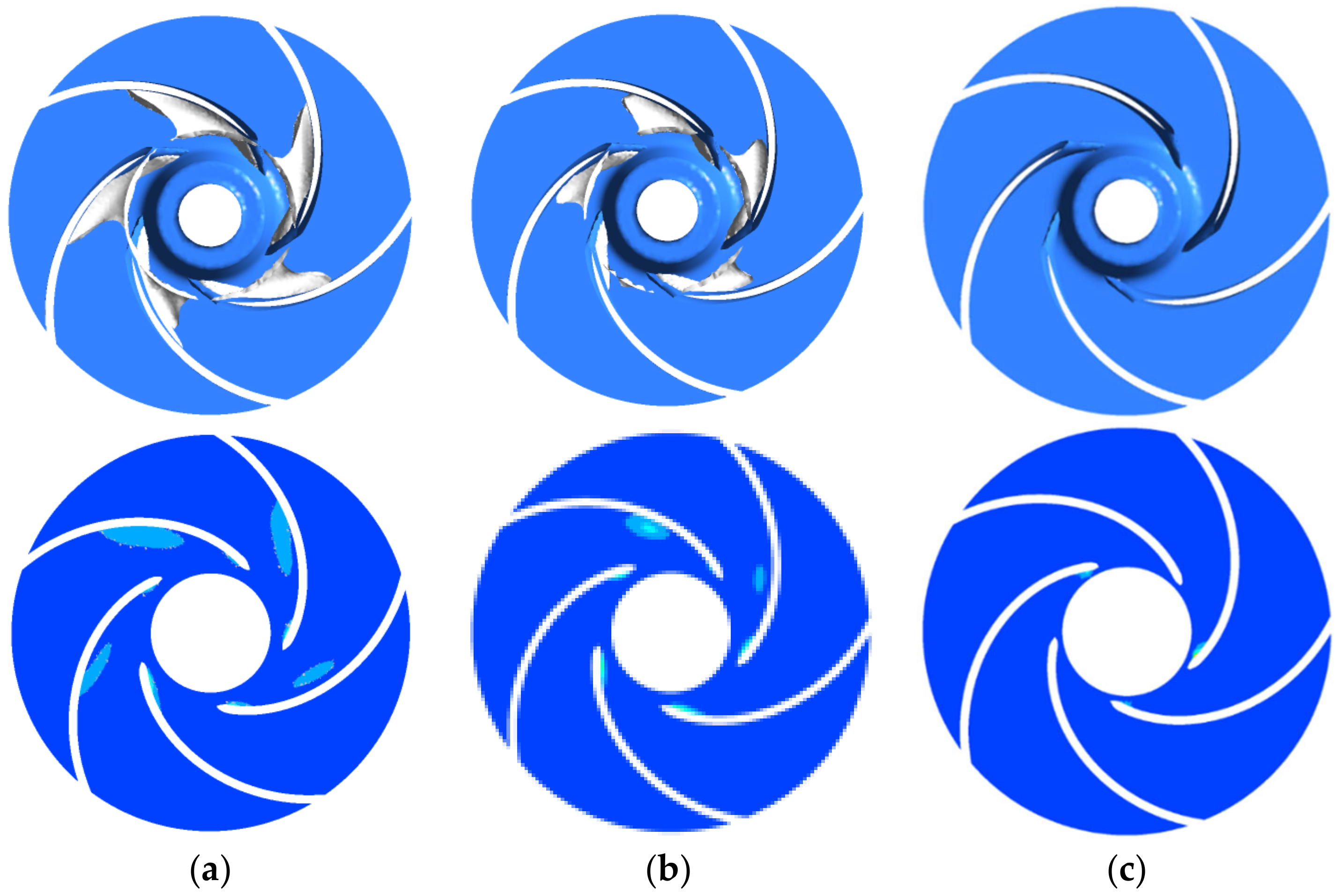
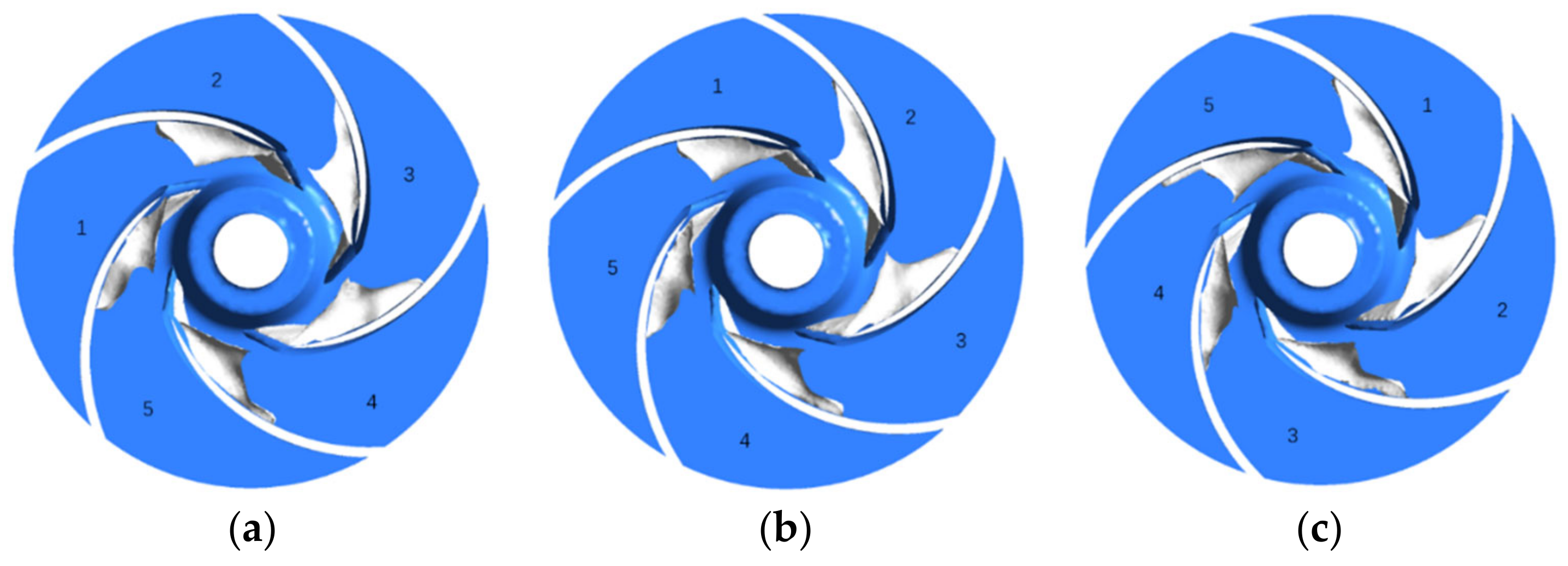

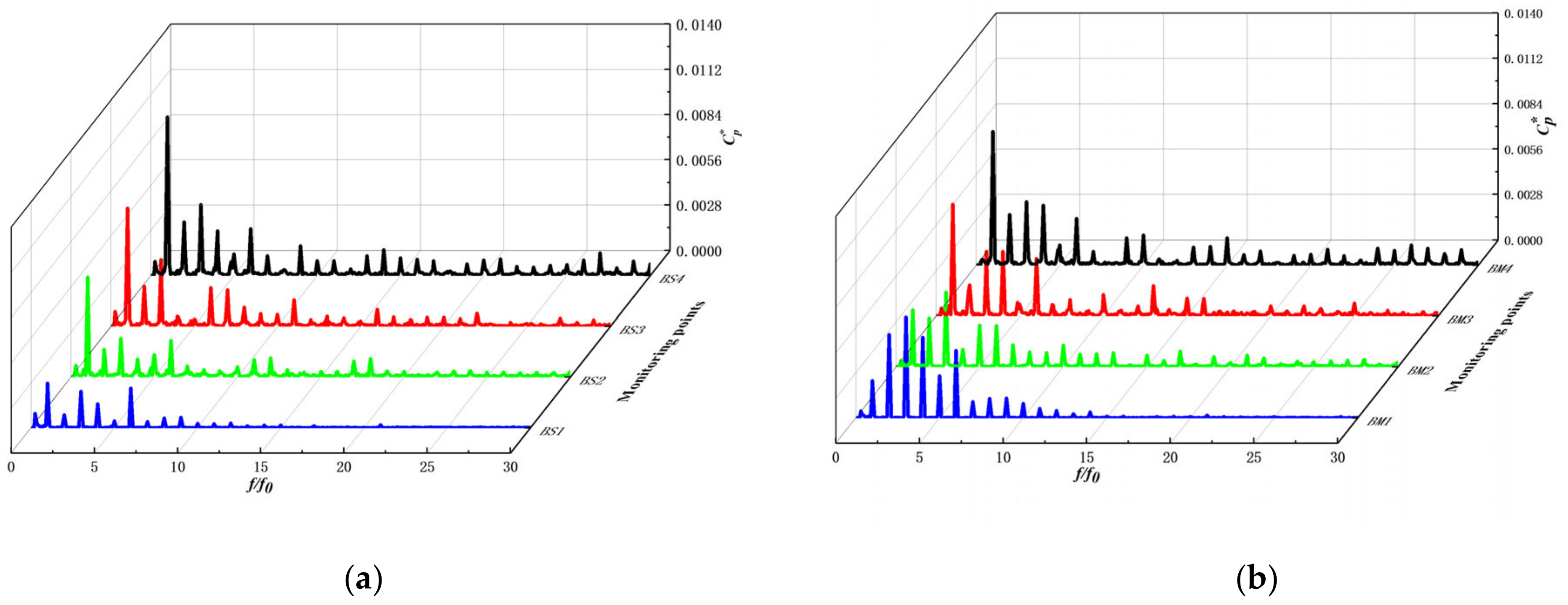
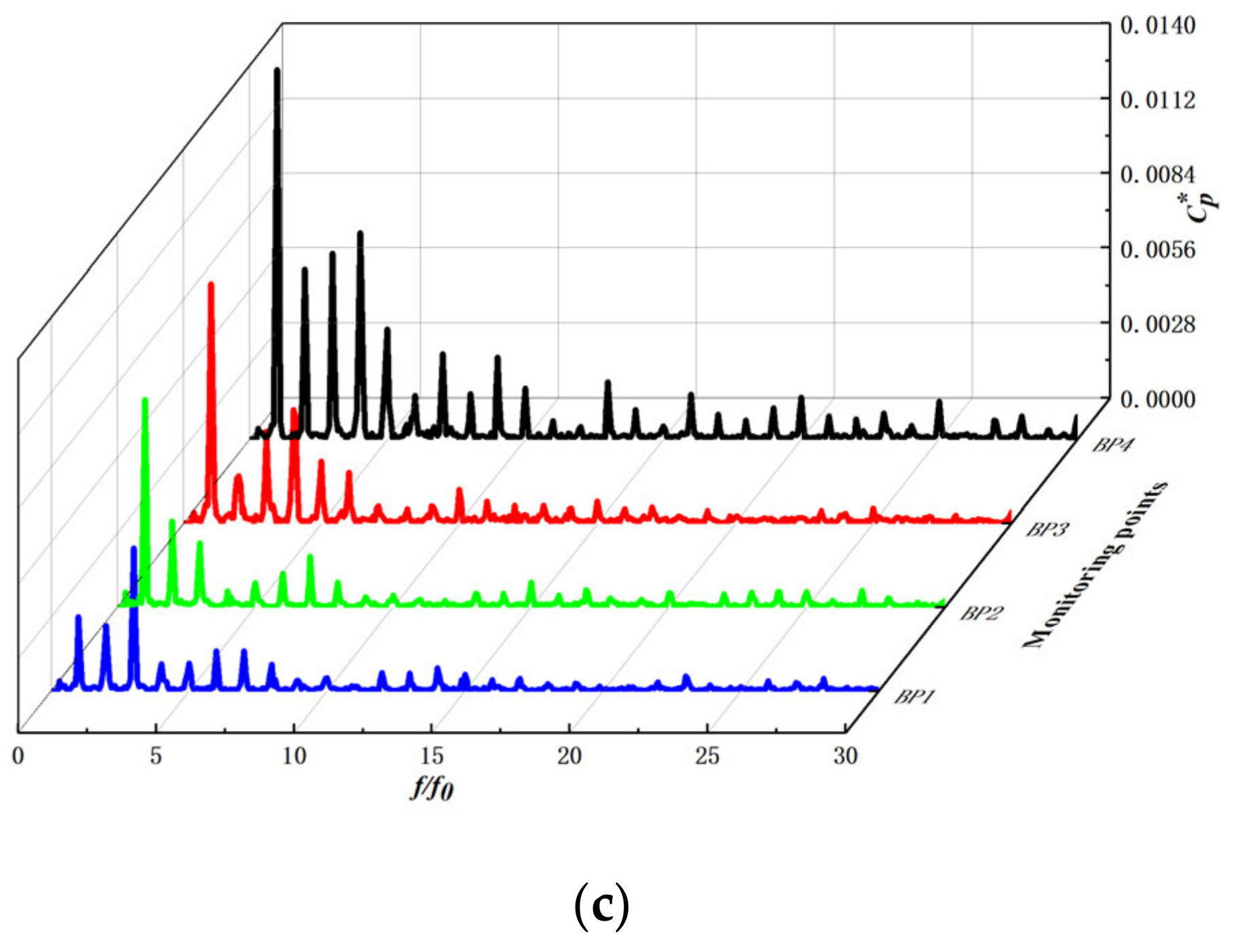

| Parameters | Value |
|---|---|
| Rated flow rate, Qd | 1.25 m3/h |
| Rated head, Hd | 7 54 m |
| Rated rotating speed, n | 5400 r/min |
| Specific speed, ns | 81 |
| Blade number, Z | 5 |
| Inlet diameter of impeller, Dj | 17 mm |
| Outlet diameter of impeller, D2 | 47 mm |
| Domains | Inlet Section | Impeller | Volute and Outlet | Total |
|---|---|---|---|---|
| Grid number | 328,403 | 562,914 | 833,778 | 1,725,095 |
| Node number | 57,584 | 96,006 | 143,978 | 297,568 |
| Grid quality | 0.34 | 0.32 | 0.26 | / |
| y + | 19.4145 | 38.9787 | 54.9447 | / |
| Physical Parameters | 25 °C | 50 °C | 70 °C | |||
|---|---|---|---|---|---|---|
| Water | Water Vapor | Water | Water Vapor | Water | Water Vapor | |
| Density (kg/m3) | 997 | 0.02308 | 988.1 | 0.08302 | 977.8 | 0.1982 |
| dynamic viscosity (105 Pa s) | 8899 | 0.98626 | 54.94 | 1.002 | 40.16 | 1.0817 |
| Constant pressure specific heat capacity (kJ/(kg K)) | 4.1817 | 1.9116 | 4.174 | 1.9343 | 4178 | 1962.7 |
| Thermal conductivity(w/(m K)) | 0.6069 | 0.01854 | 0.6478 | 0.02182 | 0.6676 | 0.02346 |
| Vaporization pressure (kPa) | 3.1684 | / | 12.335 | / | 31.160 | / |
Publisher’s Note: MDPI stays neutral with regard to jurisdictional claims in published maps and institutional affiliations. |
© 2022 by the authors. Licensee MDPI, Basel, Switzerland. This article is an open access article distributed under the terms and conditions of the Creative Commons Attribution (CC BY) license (https://creativecommons.org/licenses/by/4.0/).
Share and Cite
Wu, K.; Ali, A.; Feng, C.; Si, Q.; Chen, Q.; Shen, C. Numerical Study on the Cavitation Characteristics of Micro Automotive Electronic Pumps under Thermodynamic Effect. Micromachines 2022, 13, 1063. https://doi.org/10.3390/mi13071063
Wu K, Ali A, Feng C, Si Q, Chen Q, Shen C. Numerical Study on the Cavitation Characteristics of Micro Automotive Electronic Pumps under Thermodynamic Effect. Micromachines. 2022; 13(7):1063. https://doi.org/10.3390/mi13071063
Chicago/Turabian StyleWu, Kaipeng, Asad Ali, Changhong Feng, Qiaorui Si, Qian Chen, and Chunhao Shen. 2022. "Numerical Study on the Cavitation Characteristics of Micro Automotive Electronic Pumps under Thermodynamic Effect" Micromachines 13, no. 7: 1063. https://doi.org/10.3390/mi13071063
APA StyleWu, K., Ali, A., Feng, C., Si, Q., Chen, Q., & Shen, C. (2022). Numerical Study on the Cavitation Characteristics of Micro Automotive Electronic Pumps under Thermodynamic Effect. Micromachines, 13(7), 1063. https://doi.org/10.3390/mi13071063









